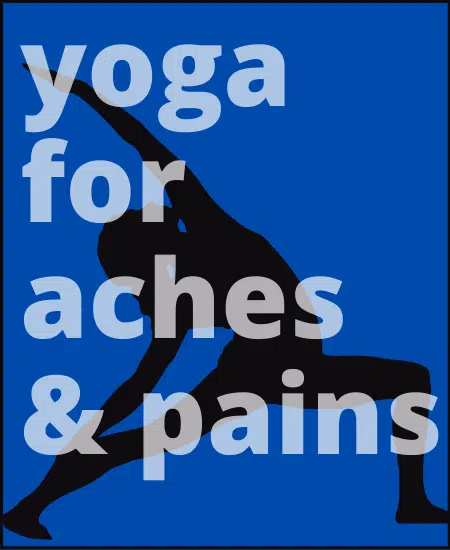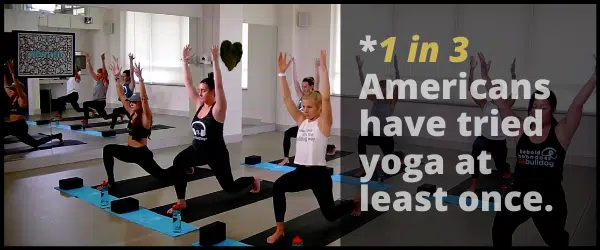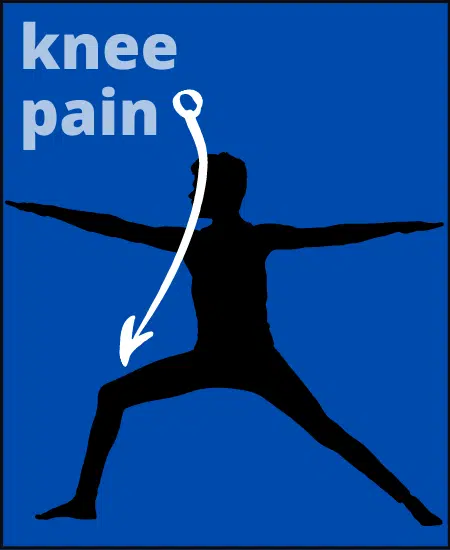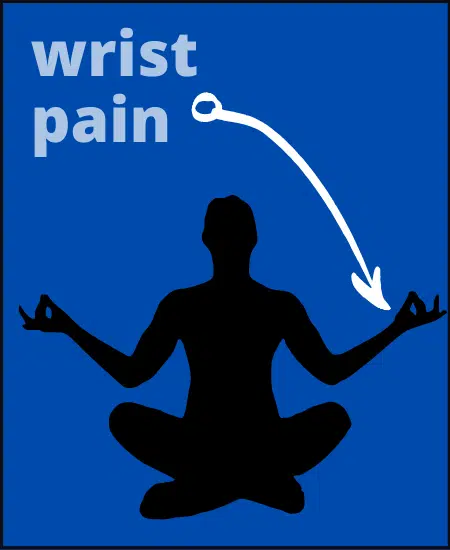Yoga is becoming more popular as people learn about its benefits and how consistently flowing can aid with pain relief. And, yes, yoga for pain relief is a real thing — read on!
One reason it’s so awesome. It can be used by anyone — and for a wide range of reasons.
And it’s good for so many aches and pains from back issues to neck and knee problems and more!
Yoga for pain relief is very popular – And also effective when done the right way…
Yoga helps bring attention to the unity of mind, body, and spirit, and it can be adapted based on ability and physical limitations. Since yoga is a low-impact exercise, people can find relief when they use yoga for pain, such as to recover from an injury or to ease muscle tension.
The Good Body says:
“Approximately one in three Americans have tried yoga at least once.”
Whether you’re recovering from an injury or simply have a strain or tension that needs to be addressed (yikes!), yoga may just be the solution.
Be 1 of the 3 😉
You’ll be hooked with our fun and easy-to-follow classes!
First, You Need to Understand How to Practice & Incorporate Yoga into Your Daily Life
There are lots of ways to incorporate yoga into your life, depending on your needs. The reason you decide to start yoga might impact the way you work it into your routine.
Pain Relief & Restorative Yoga can help with the following…
- Physical exercise benefits will have you working out more frequently and intensely but that’s not the whole picture.
- Mental and emotional health combine together in a yoga workout that focuses on deliberate movements and longer poses to ~relax~ and clear your head.
- A spiritual/individual practice can make it more than just a workout may be just what you need to do on your own, instead of in a class (It may just feel more personal).
Yoga is extremely versatile and works as a great morning stretch routine. It can be used by anyone, no matter their physical capabilities or limitations. Poses can be adapted based on your abilities and needs. For this reason, yoga can be highly beneficial for anyone, no matter your goals!
Can Anyone Do Yoga for Pain Relief & Exercise?
It is always recommended to speak with your doctor first before using yoga for pain relief but, for the most part, yoga is suitable for most people rehabbing from injuries and limitations.
There are many different styles of yoga and not all classes will be suitable for you at this point in your life. If you have more specific needs then start with a private class, ideally with a Yoga Therapist.
“But why yoga for pain relief?”
Yoga is often thought of mostly as an exercise program to help people achieve their health goals, but it can be an effective method for pain relief, as well. In most exercise programs, pain means adapting your exercise program or even taking days off.
That’s not how it works with yoga!
In fact, a yoga practice can be a good way to help ease the pain while still making progress toward health and wellness goals. You don’t have to take a break to feel better! Plus, it can be applied to many different types of pain throughout your body. One great example is the normal aches and pains that runners experience. After all, running is hard on your body (but it’s a great sweat!!!💦). Runners — check out our advice on yoga for runners in this video.
If you are seeing a health care provider for pain or injury, you should definitely discuss yoga with them before you start with it as part of your treatment — aka do not use yoga as a substitute for medical attention.
Yoga can help with pain relief from:
Yoga for Back Pain Relief
A lot of adults complain about back pain. (Getting older kinda sucks sometimes.) In fact, this is such a complex topic that we dove deeper into the benefits of yoga for back pain.
Many things can cause back pain, but since you use so many back muscles for everyday activities, you are more likely to feel the back pain just by trying to live your life. Fortunately, yoga can be an effective way to ease back pain so you don’t have to deal with it doing daily activities.
Dr. Lauren Elson, the Medical Editor of the Harvard Special Health Report An Introduction to Yoga, says:
“Yoga helps strengthen and stretch back muscles that might be tight, which improves mobility.”
Since yoga focuses on poses and slow stretching, different positions can be used to stretch and move the back and spine, bringing it into better alignment and easing the pain. Poses can also stretch tight muscles and help work out knots.
If you use yoga to help ease back pain, it’s important to use proper positioning for the poses and ease into them. Improper positioning and rushing the timing can aggravate back injuries or even cause pain that didn’t previously exist. Taking a class or working with a yoga instructor can help ensure that your yoga practice is actually effective for easing back pain.
Check out yoga classes that focus on your upper and lower back.
Yoga for Neck Pain Relief
Along with back pain, neck pain is common, especially as you age. It can come from sleeping incorrectly, sitting in a certain position too long, or even spending a little too much time on your mobile device (guilty!).
Yoga International confirms:
“The most common cause of neck pain is stress on muscles and ligaments stemming from poor postural habits, which are often related to our computerized, stressful, sedentary lifestyle.”
But we have more good news! Yoga can be a good way to ease your neck pain, no matter the cause. Many yoga poses involve the entire spine, which includes the neck. As a result, you can use yoga poses to stretch and turn your neck to release tense muscles and help keep your neck in good health.
When you incorporate yoga to help ease neck pain, resist the temptation to push too hard. One of the many benefits of yoga is that it uses a gentle approach to physical health. Adapting yoga poses based on your skill level, mobility, and pain levels will help ensure that you don’t hurt yourself further with yoga. After all, we’re not here to make things worse.
Don’t forget: working closely with a teacher can help you learn proper poses and the safe adaptations you may need. Check out more info on yoga for neck pain.
Yoga for Knee Pain Relief
Yoga can help relieve the pain you experience in your knees. Your knees take on a lot to keep you moving, so yoga can often combat the harm you do to your knees day-to-day. They carry the weight of your body when you stand and walk. They’re also the meeting point of three different bones, which makes them a vulnerable part of the body and can lead to discomfort, even when you do your best to take care of your knees.
You can develop painful knees if you’re active, or even as you age. Since your knees are such a big part of your regular activities — including something as simple as walking! — painful knees can have a negative impact on your daily life.
You may think that yoga is hard on your knees because the poses require balance and lots of bending and straightening your lower body. Actually, yoga can be a useful exercise to ease knee pain discomfort, as long as you do the movements properly.
The Art of Living explains:
“Yoga helps to keep knees healthy and strong by lengthening and strengthening the surrounding thigh and calf muscles, thus helping to ease the pressure on the knees. Injuries and knee problems are often due to mechanical issues with the kneecap, which then impacts the ligaments and the joints, but most exercises fail to equally develop the inner, outer, upper and lower muscles.”
Yoga is a gentle way of engaging the legs and building leg strength, which can heal knee injuries and prevent future knee injuries. The movements and poses used in yoga can be used to stretch and strengthen the legs and knees, making them better equipped to handle your daily life. Again, we took a deep dive specifically into yoga for knee pain. Read on!
Yoga for Hip Pain
Hip pain can be debilitating because it may affect every aspect of your day. It’s difficult just to walk with hip pain, but it can also be difficult to sit and lay down. Ugh!
The Joint Chiropractic describes why yoga for hip pain is beneficial:
“Particularly when it comes to hip pain, yoga works to strengthen the muscles that support the joint and stabilize it. It also works to increase the joint’s range of motion. Plus, it’s a low-impact exercise that’s easy for people of all fitness levels.”
Fortunately, there are yoga poses designed specifically to help with easing hip pain so you can get through your day more easily. Poses that open your hips will help with pain from inflammation or injury. They can also reduce your chronic pain!
Not all hip-opening poses are suitable for everyone, especially if you’re recovering from an injury. As with any yoga practice, you need to listen to your body so you don’t injure yourself further. Depending on the cause of your pain, you may find certain poses more effective than others. You can also adapt some poses to be easier on your hips so you can continue your yoga practice, even after an injury or hip pain. You guessed it! We have even more info on yoga for hip pain so you can make the best decisions for your body.
Yoga for Wrist Pain
Wrist pain is all too familiar for parents and professionals with a desk job. If you spend most of your day at a computer, you may be vulnerable to carpal tunnel or other wrist injuries or pains. Pain in your wrist can mean it’s difficult to lift or hold anything, even your water bottle!
Though there are some yoga poses that put weight on your hands and wrists, you can use yoga for pain in your wrists to find relief and strengthen the muscles and ligaments to prevent future injuries.
This ESPN article stresses the importance of wrist care for athletes:
“As an athlete, you need to have grip strength, be able to absorb falls and have powerful arm strength. One key to gaining those qualities is a supple wrist. If you’re at your desk all day you’re overdeveloping all the tiny muscles in your hands and wrists, which can then develop chronic pain.”
Be aware of how you put your weight on your wrists during your yoga practice. When you come out of a pose, stretch your wrists by rotating them slowly to keep them from getting too tense.
As your wrist is healing, don’t be afraid to adapt your yoga practice so you don’t put too much strain on your wrists. Try doing some poses in your chair at work if you’re worried about using your hands to support yourself on your yoga mat!
You can find yoga classes specifically targeting each of these areas
Backs, neck, hips, wrists … oh my!
The Mental & Emotional Benefits of Yoga Beyond Physical Rehab
While yoga is a physical practice, the mental and emotional aspects are just as important. Yoga is a meditative practice, engaging the mind, body, and spirit as one to offer benefits to the whole being. Even if you develop a yoga practice for its physical benefits, the mental and emotional benefits will become apparent. All of the benefits will help you create a healthier, happier mind, body, and spirit. What’s not to love?
Stress Reduction
One of the best-known benefits of yoga is stress reduction. Yoga combines physical movements with breath and mindfulness to bring awareness to the connection of mind, body, and spirit. When you focus on your poses and breathing in this way, the meditative element of yoga comes into focus, allowing you to let go of things in your life that cause stress and frustration. Even a short daily practice will help you let go of stressors in your life so you can feel more at peace.
Depression & Anxiety Management
Depression and anxiety can arise either from circumstances or a chemical imbalance in the brain. Either way, they are tough to deal with. And you deserve to feel better! Yoga is often recommended to help ease the symptoms of depression for the same reasons it helps with stress reduction. By being mindful and focusing on the mind-body-spirit connection, you can improve your mental and emotional well-being, which then contributes to your improved overall health.
Meditation
Many people use yoga as a form of meditation. The slow movements and attention to breath can help you to turn your attention away from the thoughts and distractions of life. In meditation, your goal is to be in the present moment. Allow extraneous thoughts to pass through before bringing your attention back to the present moment. Yoga can be especially helpful for those who want to meditate, but struggle to sit still for very long to do it.
And, while we are on the topic of meditation 🧘♀️, check out our video about meditation’s many benefits and tips on how to start and stick with it (we get it…it’s hard!)
Yoga for Weight Loss
Though some people tend to emphasize the benefits of yoga for pain relief and mental/emotional benefits, yoga is ultimately a physical practice. This means it can be used to achieve your physical health and fitness goals, just like other exercise programs.
We’re not here to suggest that you need to set any weight loss goals (as far as we’re concerned, the only things you need to have for a yoga body are yoga and a body), but if you are concerned with weight, listen up: Yoga can be particularly effective for weight loss because it is more low-impact then other exercises. Other programs, like running, can be hard on joints or certain parts of the body. Even though you’re achieving your weight loss goals, you’re taking a toll in the process. Yoga uses slow movements and held poses aligned with breathing to move your body.
For some people, yoga may not be enough on its own to achieve your weight loss goals. And that’s okay, too! Talk with your care provider and your yoga teacher to figure out the best next steps for you.
Yoga for Strength Training
Many people use yoga to build strength, as well as flexibility. When you move your body in yoga, you are moving the weight of your body, which takes strength. This is called “body-weight training.” Even though yoga is low-impact and uses slow movements, the muscles used to hold poses (and move from pose to pose) require physical strength.
The more you do yoga, the stronger your body will become and the easier it will be to practice on a regular basis. As you become stronger, you can start to incorporate more advanced poses into your practice. These advanced poses require greater strength and flexibility, so you will continue to move toward your health and wellness goals. In addition, different poses focus on different parts of the body. That means you can develop yoga routines that give attention to the areas of the body you want to work on.
Get Started with Yoga for Pain Relief
Whether you started a yoga practice to benefit your mind, body, spirit, or all three, yoga for pain relief is a big benefit of the exercise.
Different poses can concentrate on different parts of the body so you can ease your pain, and even strengthen your body to prevent injuries in the future. Plus, unlike more intense forms of exercise, yoga can be practiced without a rest day incorporated (if you want!) into your exercise regimen.
Consistency is key! 🔑
Or take the quiz to have a fun, custom plan designed just for you!

















